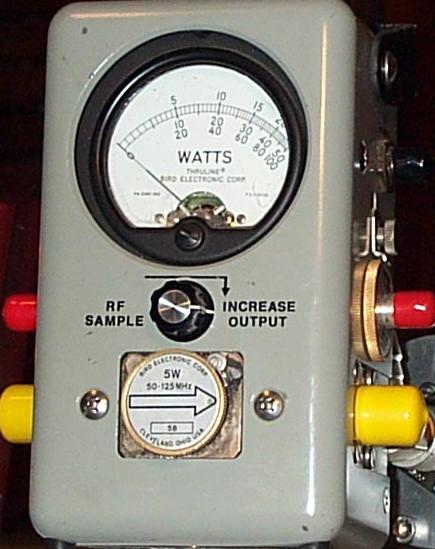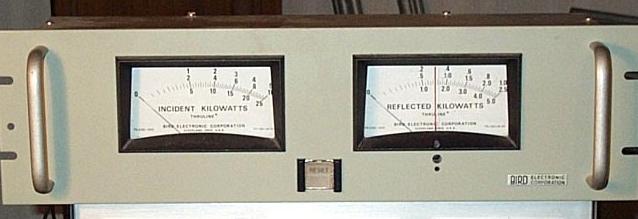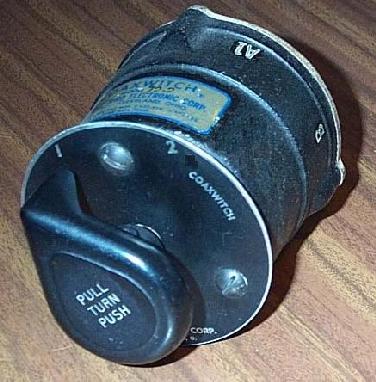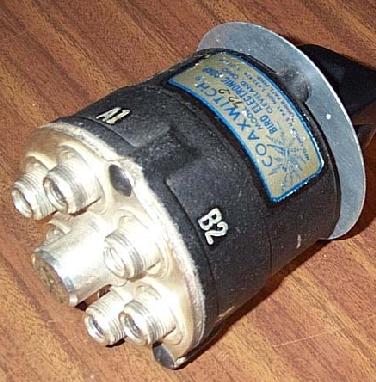
Hi, I am Tony I0JX
Some tips on Bird equipment
Equipment manufactured by the Bird Electronic Corporation, wattmeters, RF loads, switches, etc., have always been very fascinating to me. Unfortunately they are very expensive and not easy to find at reasonable prices on the surplus market: don't rely on Ebay; who knows why people there seem to be prepared to pay used stuff, with no warranty, nearly the same price as new!
I have began looking for Bird instruments at least 25 years ago, so I today have a pretty good selection of items. Without repeating what you can find in the Bird products catalog, and I'll mainly tell something on Bird wattmeters, with particular regard to the high-power ones, quite uncommon instruments which you may happen to pay an affordable price, usually less than what you would pay for the most common and well-known "Model 43".
Model 43, which has been sold in more than 150,000 units since 1952, basically consists of a 7/8-inch hard-line section, two "quick-change" connectors (a wide selection of connector types is available), a meter and a die-cast housing. Paying the wattmeter (at the retail price of some 250$) is just the beginning of the money flow: as a matter of fact the wattmeter does nothing until you get one or more plug-in units or "slugs" for the power level and the frequency range of your interest.
The most common frequency ranges are:
For each of the above ranges you can get slugs of different full-scale power, that is 50 W, 100 W, 250 W, 500 W, 1000 W. For range H only, 2500 W and 5000 W slugs are also available. For instance, the slug marked "500H" is 500 W, 2-30 MHz. Frequency ranges are nominal; a slug may satisfactorily work beyond the stated range, and this is more and more true the higher the slug power is. The slug can be rotated to alternately measure forward and reflected power; in reality you may have to change slugs quite often as, for instance, a 2500 W slug may be good for measuring forward power but it may not yield a good accuracy and resolution for measuring reflected power. For this reason line sections hosting two slugs are also available. Price ranges: H-slugs current retail price is around 93$ for power up to 1000 W, or around 130$ beyond that. All other slugs are around 80$ flat. It is easy to spend 1000$ or more for a good selection of slugs (however, Bird also sells switchable wattmeters, like the 4304A having a single multi-range multi-power element, or the 4410A using a set of multi-power slugs).
The are several products directly derived from Model 43, such as the rack-mounted Model 4521, or Model 4431 having a variable RF tap (see picture below).

The hard-line diameter is the same (7/8-inch) for all such variants of the original Model 43, which then use the same type of meter (30ua, 1400 ohm) and the same set of slugs (apart from very special cases).
The continuous power-limit of standard Model 43 is declared to be 5000 W (range H) or 1000 W (ranges A ... E). However you may still use that wattmeter beyond those limits (up to 10 KW, for all ranges) by using the so-called "pulse-power" slugs which, though intended for peak-power wattmeters like the Model 4314B, work equally well with the normal Model 43. The issue is quite simple: Bird does not guarantee that Model 43 will withstand 10 KW average power 24-hour a day, but there will be no harm in making occasional measurements at that power level, or operating SSB/CW at 10 KW peak power. Current retail price for the 10000H slug (10 KW, 2-30 MHz) is around 162$.
In addition to Model 43 and its derivatives, Bird produces a number of high-power wattmeters utilizing bigger hard-line sections, i.e. 1 5/8-inch, 3 3/8-inch and 6 1/8-inch (lately a 4 1/16-inch line was also introduced). Such sections are typically flanged (EIA standard), but you can buy adapters fitting the normal Bird quick-change connectors. Picture below shows the single-slug 1 5/8-inch hard line of Model 4712 wattmeter, the power limit of which is 25 KW (ranges H ... B), 10 KW (range C) or 5000 W (ranges D and E).

Next picture shows the 3 3/8-inch hard line of the Model 4610 wattmeter (that's really heavy, imagine the 6 1/8-inch line!).

Model 4610 holds two slugs, so you can simultaneously read forward and reflected power. Power limit is 100 KW (range H), 50KW (ranges A ... C) or 25 KW (ranges D and E).
Each wattmeter type utilizes a different set of slugs, which is bound to the line-section diameter; for instance slugs intended for the 1 1/8-inch line bear a "1" at the end of the designator (e.g. 2500H1), for the 3 3/8-inch line they instead bear a "3" (e.g. 5000A3), or a "6" for the 6 1/8-inch line (e.g. 5000A6).
Conversely all high-power wattmeters, irrespective of the hard-line diameter, use a single meter type, that is 100uA 3000 ohm (although slugs compatible with the standard Model-43 30uA meters have lately also been introduced).
You may either use the meter which comes with the wattmeter (see below)

or instead use what they call the "Wattcher", including two rack-mounted meters and some electronics (my Wattcher is model 3127).

The reflected-power meter of the Wattcher (the right-hand one) has two needles, one of which (the red one) can be externally adjusted with a screwdriver. When reflected power exceeds a limit, the two needles get in contact with each other and an alarm is raised, automatically de-activating the transmitter.
To complete the tour, let us briefly address the Bird coaxial switches. The "Coaxwitch" adopts quite a unique design, permitting operation up to 10 GHz, at high power, with negligible crosstalk, low loss and VSWR. The switching mechanism is 4½-inch of coaxial cable which is pulled away from the mating male N connectors and rotated to the desired switch position.

To operate the switch, the knob must be grasped, pulled out, rotated and pushed in to make contact.
This is how a model 72-2 switch looks like in the reality (note: the front panel of newer switches is black-on-white rather than white-on-black).


They come in three types:
The drawing below pictorially shows the above examples.

As to power handling, the internal cable is a teflon RG-87A/U or RG225A/U, which withstands very high power: from 42 KW (yes, forty-two kilowatt) @ 1 MHz to 1.2 KW @ 1 GHz. But, you shall also take into account the power handling capability of the N-type connectors. Bird declares for their switches 850 W continuous @ 100 MHz or 75 W @ 4 GHz. In practice, plug it in anywhere and forget it.
Return to the I0JX home page
This page hosted by ![]() Get your own Free Home Page
Get your own Free Home Page